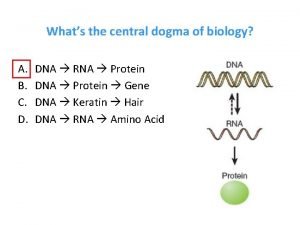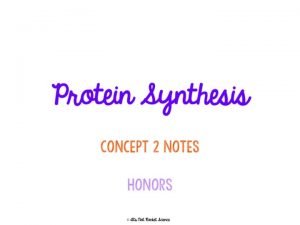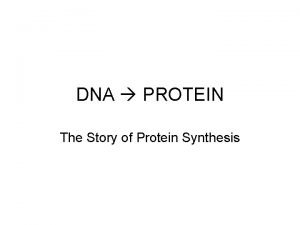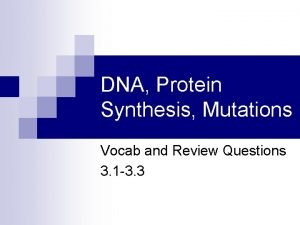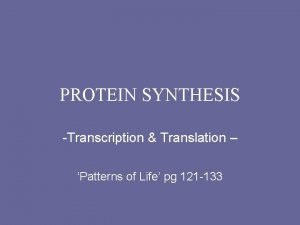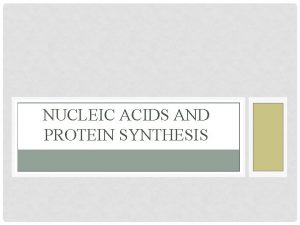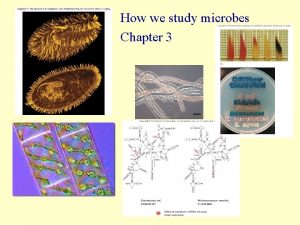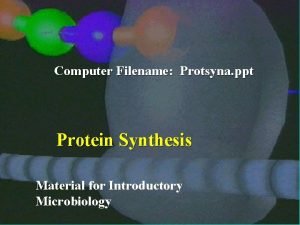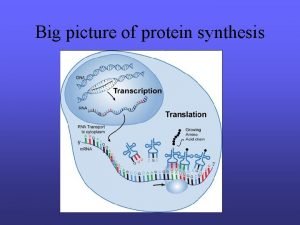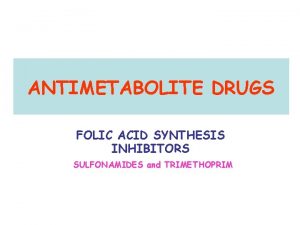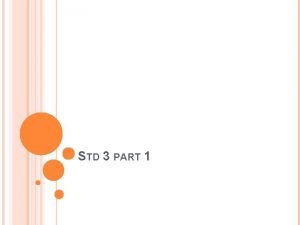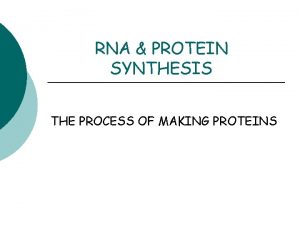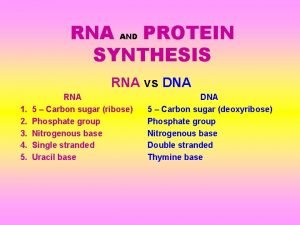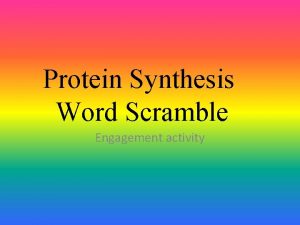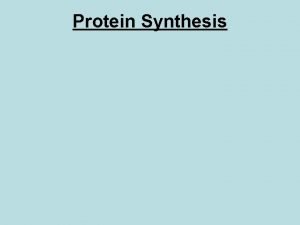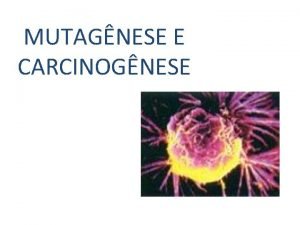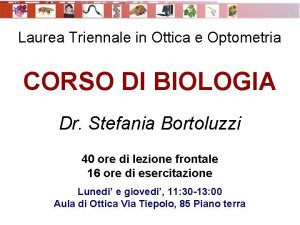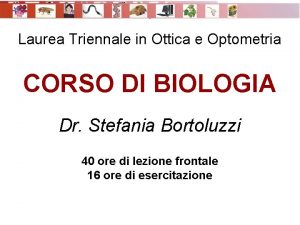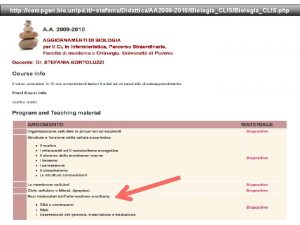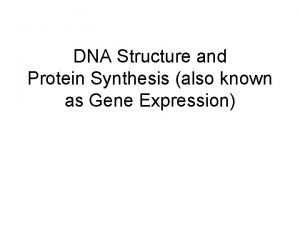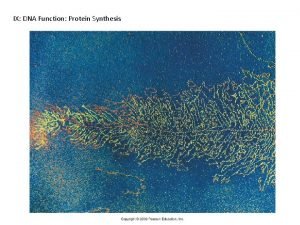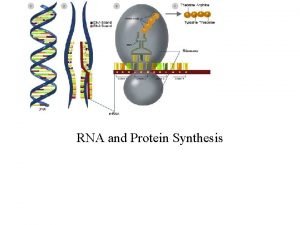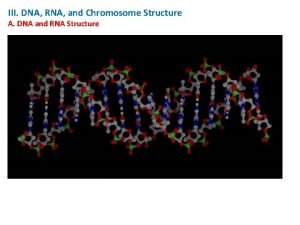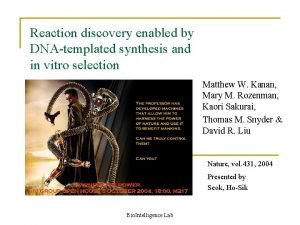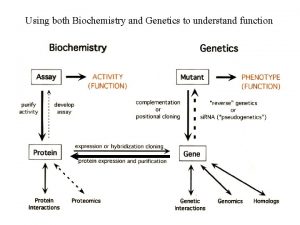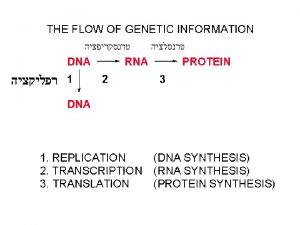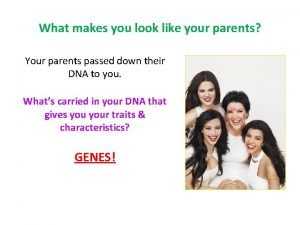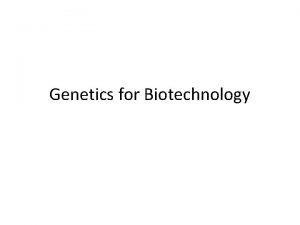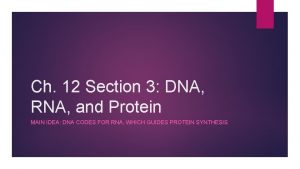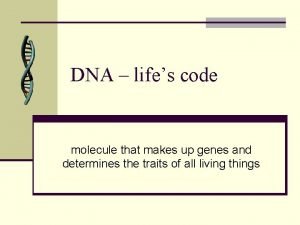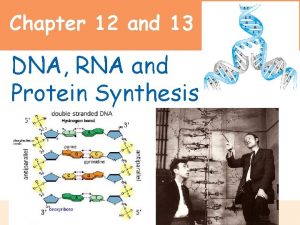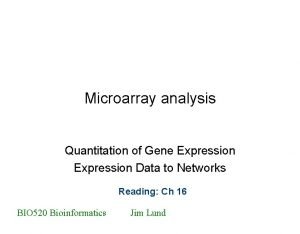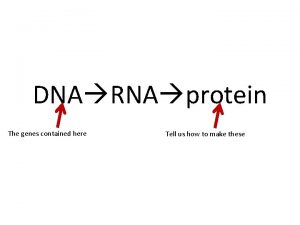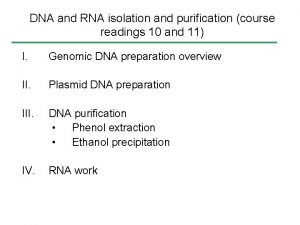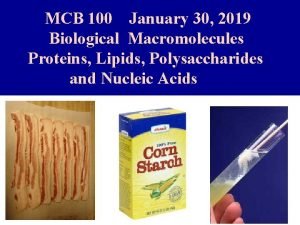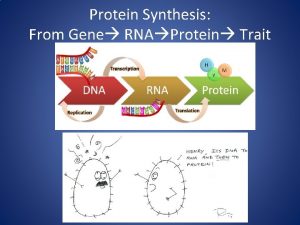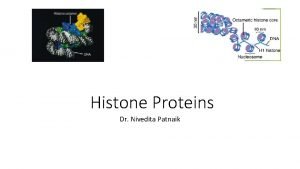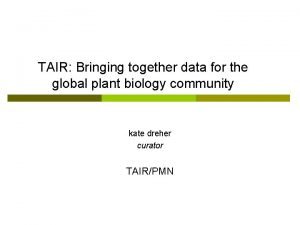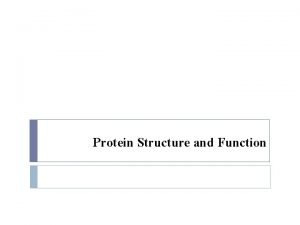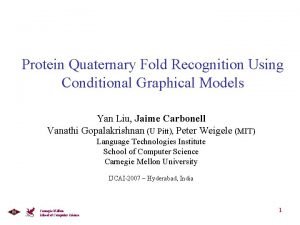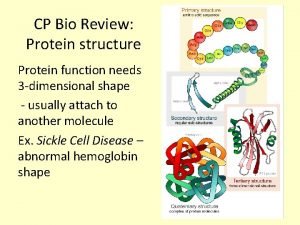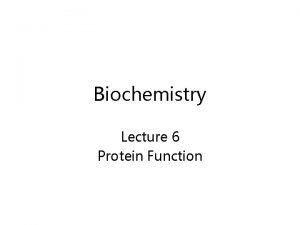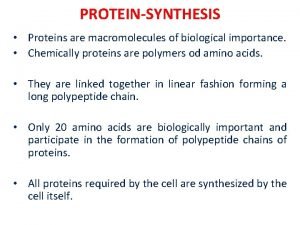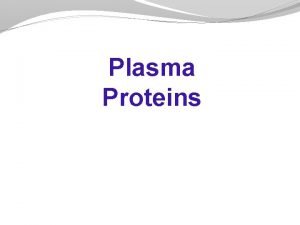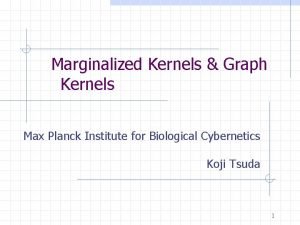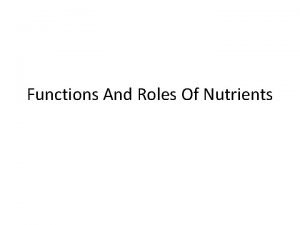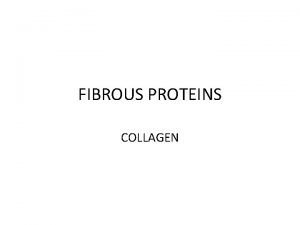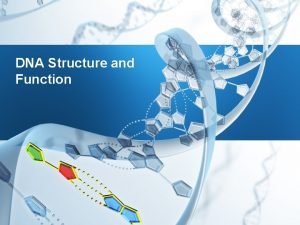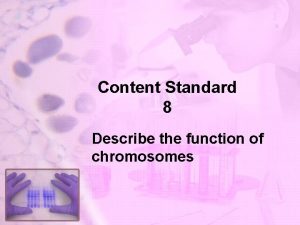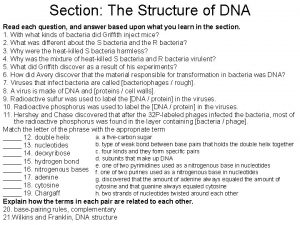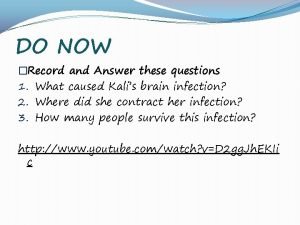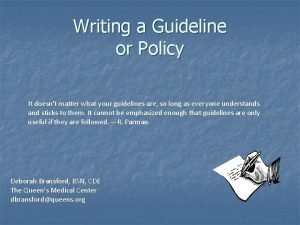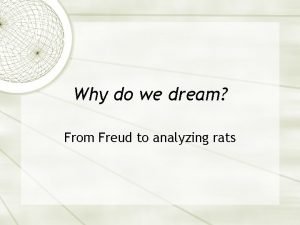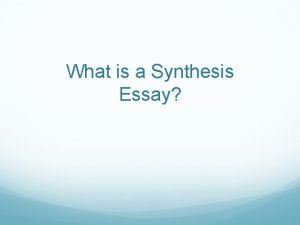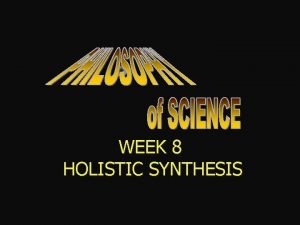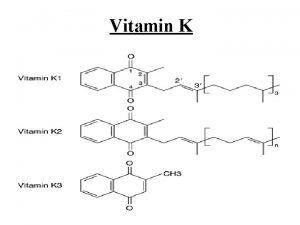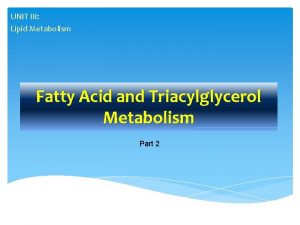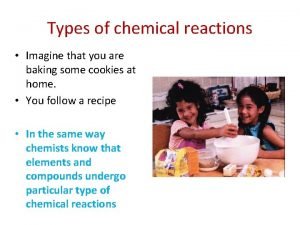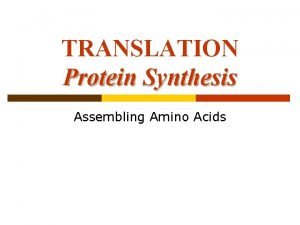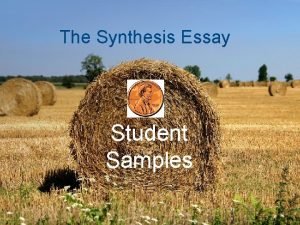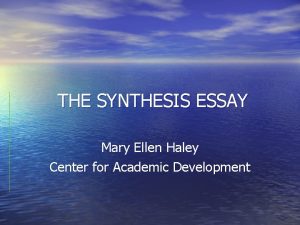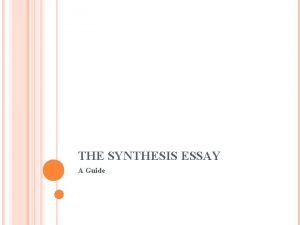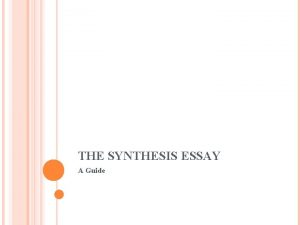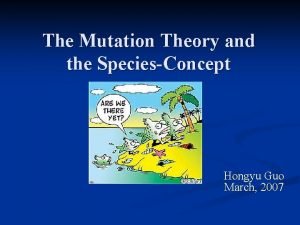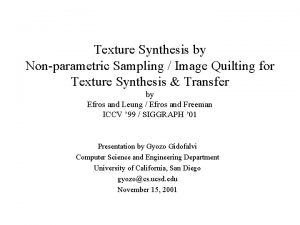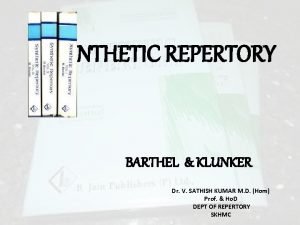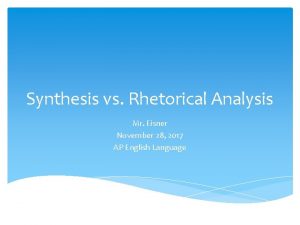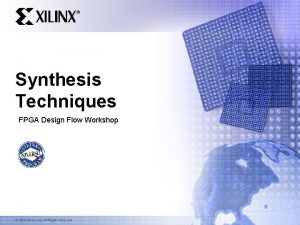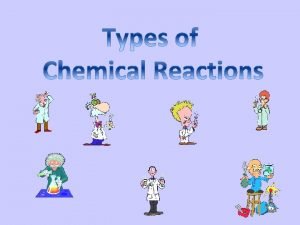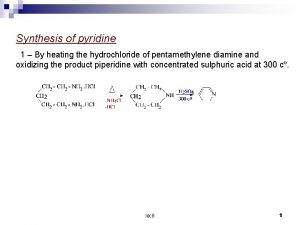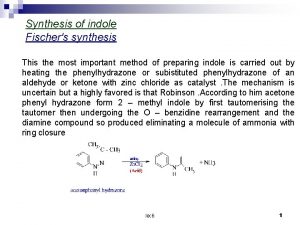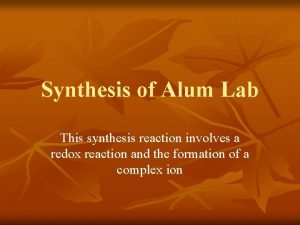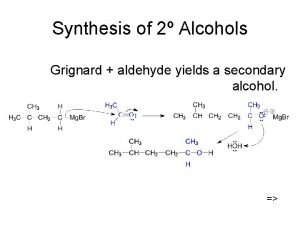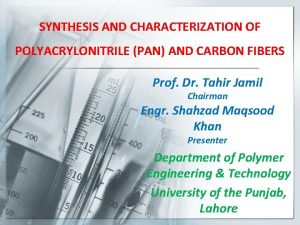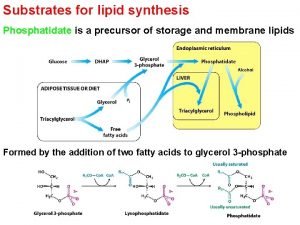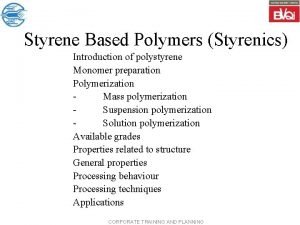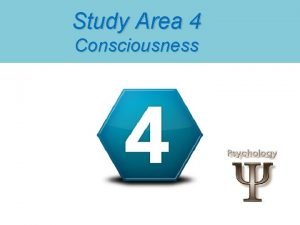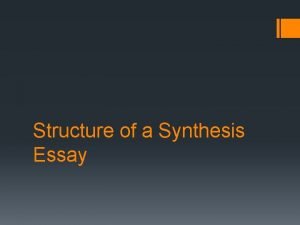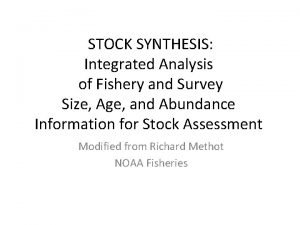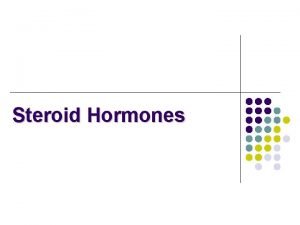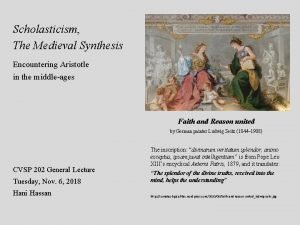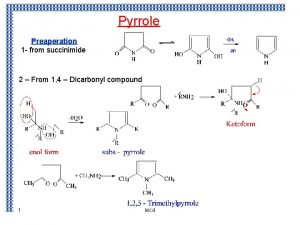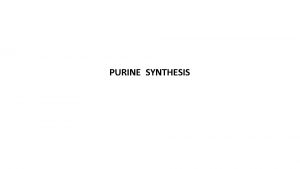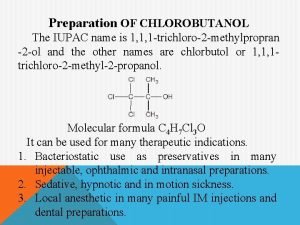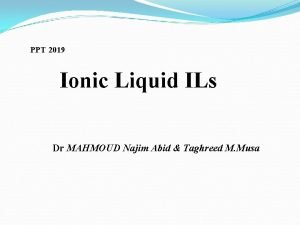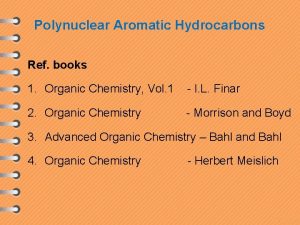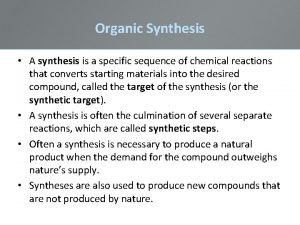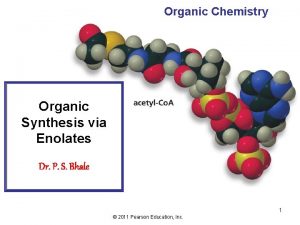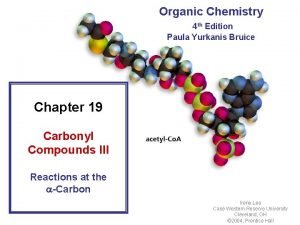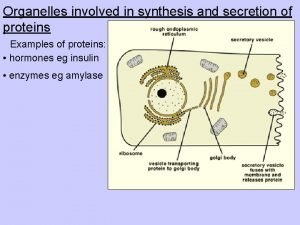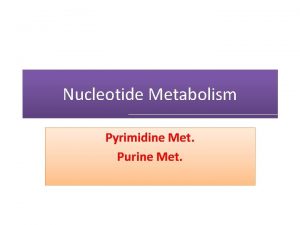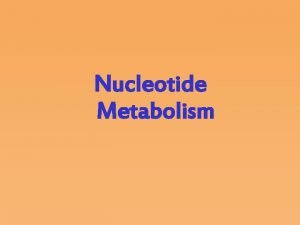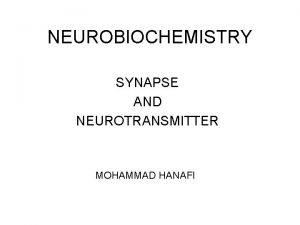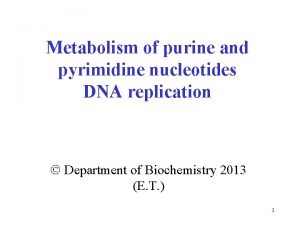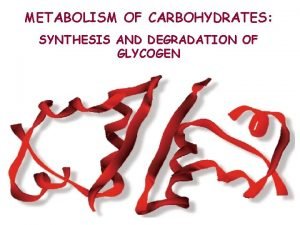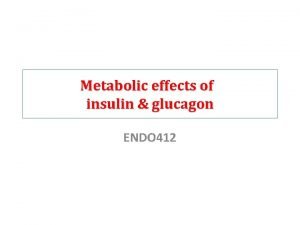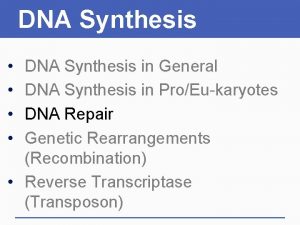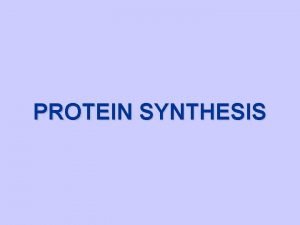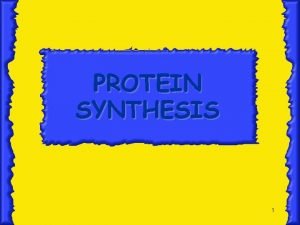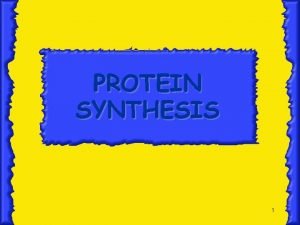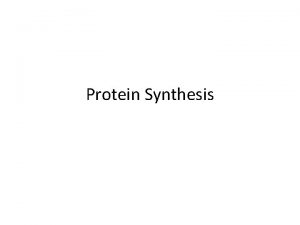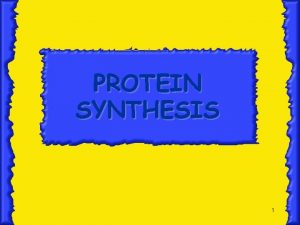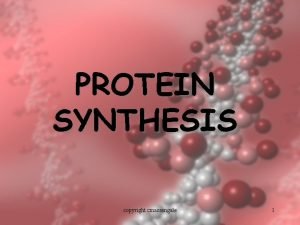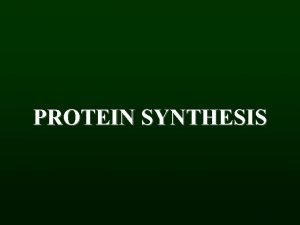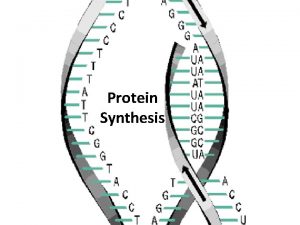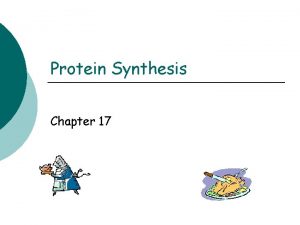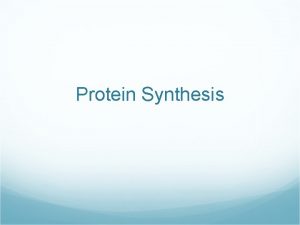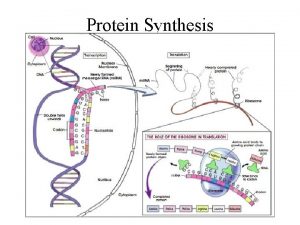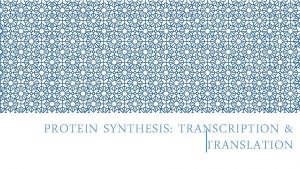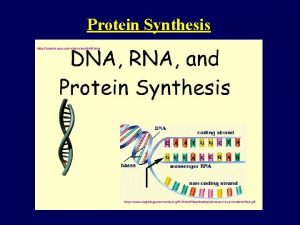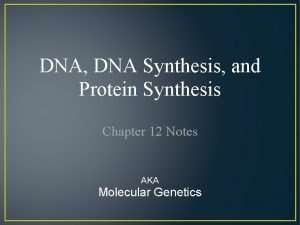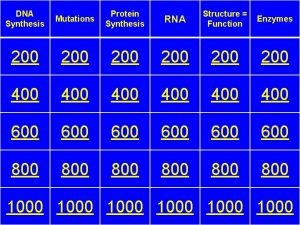IX DNA Function Protein Synthesis IX DNA Function































































































































- Slides: 127

IX: DNA Function: Protein Synthesis

IX: DNA Function: Protein Synthesis A. Overview: 1. The central dogma of genetics: unidirectional flow of information

IX: DNA Function: Protein Synthesis A. Overview: 1. The central dogma of genetics: unidirectional flow of information 2. Why a two-step process? a. Historical contingency… That’s how it evolved from an RNA Protein system…

IX: DNA Function: Protein Synthesis A. Overview: 1. The central dogma of genetics: unidirectional flow of information 2. Why a two-step process? - it evolved that way…. - because it is more productive…. t. RNA

IX: DNA Function: Protein Synthesis A. Overview: 1. The central dogma of genetics: unidirectional flow of information 2. The code is: 3. Why a two-step process? 4. Players: ds-DNA; GENE (recipe) RNA polymerases make: m-RNA (gene transcript) r-RNA (reader in ribosome) t-RNA (AA carrier) t. RNA

IX: DNA Function: Protein Synthesis A. Overview: B. Transcription:

IX: DNA Function: Protein Synthesis A. Overview: B. Transcription: 1. The DNA template: 3’ ‘sense’ strand 5’ …C A T… 5’ …G T A… ‘anti-sense’ strand In a given region (gene), only one strand is transcribed; only one strand carries a message that makes ‘sense’. The sequence on the other strand is limited to being complementary to the first strand. 3’

IX: DNA Function: Protein Synthesis A. Overview: B. Transcription: 1. The DNA template: 3’ ‘sense’ strand 5’ …C A T… 5’ …G T A… ‘anti-sense’ strand In a given region (gene), only one strand is transcribed; only one strand carries a message that makes ‘sense’. The sequence on the other strand is limited to being complementary to the first strand. There is a region ‘upstream’ from the gene called the PROMOTER. This is where the RNA Polymerase binds. The polymerase is attracted to particular sequences. Many are consensus sequences found upstream from different genes, and across many species. 3’

IX: DNA Function: Protein Synthesis A. Overview: B. Transcription: 1. The DNA template: 3’ ‘sense’ strand 5’ …C A T… 5’ …G T A… 3’ ‘anti-sense’ strand In a given region (gene), only one strand is transcribed; only one strand carries a message that makes ‘sense’. The sequence on the other strand is limited to being complementary to the first strand. There is a region ‘upstream’ from the gene called the PROMOTER. This is where the RNA Polymerase binds. The polymerase is attracted to particular sequences. Many are consensus sequences found upstream from different genes, and across many species. In all bacteria, the sequence TATAAT lies 10 bases upstream from all bacterial genes, and TTGACA lies 35 bases upstream. Two binding sites create a directionality. Promoters can be 40 bases long. Frequency of binding is affected by variation in the rest of the sequence….

IX: DNA Function: Protein Synthesis A. Overview: B. Transcription: 1. The DNA template: 3’ ‘sense’ strand 5’ …C A T… 5’ …G T A… ‘anti-sense’ strand In a given region (gene), only one strand is transcribed; only one strand carries a message that makes ‘sense’. The sequence on the other strand is limited to being complementary to the first strand. In all eukaryotes, there is a consensus sequence of TATA in all promoters at -35, and a CAAT box at -80. There also enhancer regions that can modulate binding, and Transcription Factors that bind to the promoter and increase/decrease the efficacy of polymerase binding. 3’

IX: DNA Function: Protein Synthesis A. Overview: B. Transcription: 1. The DNA template: 3’ ‘sense’ strand 5’ …C A T… 5’ …G T A… ‘anti-sense’ strand In a given region (gene), only one strand is transcribed; only one strand carries a message that makes ‘sense’. The sequence on the other strand is limited to being complementary to the first strand. In all eukaryotes, there is a consensus sequence of TATA in all promoters at -35, and a CAAT box at -80. There also enhancer regions that can modulate binding, and Transcription Factors that bind to the promoter and increase/decrease the efficacy of polymerase binding. Why is there consensus in promoter sequences across all life? What does that say about how well mutations are tolerated in these regions? 3’

IX: DNA Function: Protein Synthesis A. Overview: B. Transcription: 3’ ‘sense’ strand 5’ …C A T… 5’ 1. The DNA template: …G T A… ‘anti-sense’ strand In a given region (gene), only one strand is transcribed; only one strand carries a message that makes ‘sense’. The sequence on the other strand is limited to being complementary to the first strand. There is region downstream called a TERMINATOR (40 bases long). 3’

IX: DNA Function: Protein Synthesis A. Overview: B. Transcription: 1. The DNA template: 3’ ‘sense’ strand 5’ …C A T… 5’ …G T A… 3’ ‘anti-sense’ strand In a given region (gene), only one strand is transcribed; only one strand carries a message that makes ‘sense’. The sequence on the other strand is limited to being complementary to the first strand. So, the polymerase binds at the promoter, transcribes the whole gene, and decouples at the terminator.

IX: DNA Function: Protein Synthesis A. Overview: B. Transcription: 1. The DNA template: 3’ ‘sense’ strand 5’ Continuous recipe for a protein 5’ 3’ ‘anti-sense’ strand In a given region (gene), only one strand is transcribed; only one strand carries a message that makes ‘sense’. The sequence on the other strand is limited to being complementary to the first strand. In bacteria, the gene is a continuous coding sequence….

IX: DNA Function: Protein Synthesis A. Overview: B. Transcription: 1. The DNA template: 3’ Disconti ‘sense’ strand nuous recipe for 5’ a protein 5’ 3’ ‘anti-sense’ strand In a given region (gene), only one strand is transcribed; only one strand carries a message that makes ‘sense’. The sequence on the other strand is limited to being complementary to the first strand. In bacteria, the gene is a continuous coding sequence…. In eukaryotes, genes contain non-coding, intervening sequences called introns; the coding sequences are called exons.

IX: DNA Function: Protein Synthesis A. Overview: B. Transcription: 1. The DNA template: 3’ Disconti ‘sense’ strand nuous recipe for 5’ a protein 5’ 3’ ‘anti-sense’ strand In a given region (gene), only one strand is transcribed; only one strand carries a message that makes ‘sense’. The sequence on the other strand is limited to being complementary to the first strand. In bacteria, the gene is a continuous coding sequence…. In eukaryotes, genes contain non-coding, intervening sequences called introns; the coding sequences are called exons. Although transcription is continuous and every base is transcribed, RNA processing is required to splice out the non-coding introns and create a continuous reading frame for translation.

TANGENT

There are two alternate hypotheses for the evolution of introns: Eubacteria (no introns at all) Archaea (introns in r-RNA and t-RNA genes) Eukarya (introns)

There are two alternate hypotheses for the evolution of introns: “Introns Early”: The ancestral structure was a split gene structure, favored because evolution could proceed rapidly by the shuffling of functional exons to create new genes (exon shuffling hypothesis). Eubacteria (no introns at all) Archaea (introns in r-RNA and t-RNA genes) Eukarya (introns)

There are two alternate hypotheses for the evolution of introns: “Introns Early”: The ancestral structure was a split gene structure, favored because evolution could proceed rapidly by the shuffling of functional exons to create new genes (exon shuffling hypothesis). Eubacteria (no introns at all) Introns were lost from prokaryotes because of the extreme selective advantage for rapid division. Archaea (introns in r-RNA and t-RNA genes) Eukarya (introns)

Mitochondria have primitive spliceosomal apparatus that may have invaded eukaryotic host genome… leading to conserved phylogenetic patterns of intron position through eukaryotic evolution. VIDEO

There are two alternate hypotheses for the evolution of introns: “Introns Late”: The ancestral structure was a continuous gene structure. Introns evolved as “transposeable elements” and inserted themselves and multiplied only in eukaryotic ancestors. Eubacteria (no introns at all) Archaea (introns in r-RNA and t-RNA genes) Eukarya (introns)

The split-gene structure of eukaryotes was discovered in 1977: Philip Sharp and coworkers found that viral genes in eukaryotes and initial transcripts were longer than the functional m-RNA or proteins.

The split-gene structure of eukaryotes was discovered in 1977: Philip Sharp and coworkers found that viral genes in eukaryotes and initial transcripts were longer than the functional m-RNA or proteins. 1978: Walter Gilbert coins the terms ‘intron’ and ‘exon’.

Heteroduplex analyses of DNA and m-RNA show “loops” of RNA that have no complement in the DNA template strand:

All eukaryotic genes except those coding for histones have introns; some make up the vast majority of the ‘gene’, itself:

IX: DNA Function: Protein Synthesis A. Overview: B. Transcription: 3’ ‘sense’ strand 5’ …C A T… 5’ …G T A… ‘anti-sense’ strand 1. The DNA template: 2. RNA Polymerase: In bacteria, there is only one enzyme; consisting of a ‘core enzyme’ (responsible for polymerization), and subunits that affect different functions. For example, the sigma subunit is responsible for initiation, and the rho subunit stimulates termination. 3’

IX: DNA Function: Protein Synthesis A. Overview: B. Transcription: 3’ ‘sense’ strand 5’ …C A T… 5’ …G T A… ‘anti-sense’ strand 1. The DNA template: 2. RNA Polymerase: In bacteria, there is only one enzyme; consisting of a ‘core enzyme’ (responsible for polymerization) with two polypeptides, and subunits that affect different functions. For example, the sigma subunit is responsible for initiation, and the rho subunit stimulates termination. There are different sigma subunits that affect polymerase binding; complementing the variations in promoters. 3’

IX: DNA Function: Protein Synthesis A. Overview: B. Transcription: 3’ ‘sense’ strand 5’ …C A T… 5’ …G T A… ‘anti-sense’ strand 1. The DNA template: 2. RNA Polymerase: In bacteria, there is only one enzyme; consisting of a ‘core enzyme’ (responsible for polymerization) with two polypeptides, and subunits that affect different functions In eukaryotes, there are three RNA Polymerases: 3’

IX: DNA Function: Protein Synthesis 3’ A. Overview: B. Transcription: 5’ …C A T… 5’ 1. The DNA template: 2. RNA Polymerase: 3. RNA triphosphate precursors: A ‘sense’ strand U …G T A… 3’ ‘anti-sense’ strand A U

IX: DNA Function: Protein Synthesis A. Overview: B. Transcription: 1. The DNA template: 2. RNA Polymerase: 3. RNA triphosphate precursors: 4. Process in Bacteria 3’ ‘sense’ strand 5’ …C A T… 5’ …G T A… ‘anti-sense’ strand 3’

IX: DNA Function: Protein Synthesis A. Overview: B. Transcription: 3’ ‘sense’ strand 5’ …C A T… 5’ 1. The DNA template: 2. RNA Polymerase: 3. RNA triphosphate precursors: 4. Process in Bacteria …G T A… ‘anti-sense’ strand a. Polymerase (with sigma) lands on ds-DNA at promoter 3’

IX: DNA Function: Protein Synthesis A. Overview: B. Transcription: 3’ ‘sense’ strand 5’ C C C A G T C A T G G G T…. GGG 5’ 3’ 3’ ense’ s t rand 1. The DNA template: 2. RNA Polymerase: 3. RNA triphosphate precursors: 4. Process in Bacteria ‘anti-s a. Polymerase (with sigma) lands on ds-DNA at promoter b. Helicases separate strands; first bases linked 5’ 3’ 5’

IX: DNA Function: Protein Synthesis A. Overview: B. Transcription: 3’ ‘sense’ strand 5’ C C C A G T C A T G G G T…. G G G UC A GU A C C C A… 5’ 3’ ense’ s t ‘anti-s a. Polymerase (with sigma) lands on ds-DNA at promoter b. Helicases separate strands; first bases linked 5’ 3’ c. Sigma subunit dissociates, polymerization continues rand 1. The DNA template: 2. RNA Polymerase: 3. RNA triphosphate precursors: 4. Process in Bacteria 3’ 5’

IX: DNA Function: Protein Synthesis A. Overview: B. Transcription: 3’ ‘sense’ strand 5’ C C G C A A G C G G A A T T…. G GC G UU C G C C U U A A… 3’ 5’ 3’ 1. The DNA template: 2. RNA Polymerase: 3. RNA triphosphate precursors: 4. Process in Bacteria a. Polymerase (with sigma) lands on ds-DNA at promoter b. Helicases separate strands; first bases linked 5’ 3’ c. Sigma subunit dissociates, polymerization continues d. Termination: sequences rich in C’s and G’s, followed by A’s and T’s

IX: DNA Function: Protein Synthesis 3’ ‘sense’ strand A. Overview: B. Transcription: 5’ 1. The DNA template: 2. RNA Polymerase: 3. RNA triphosphate precursors: 4. Process in Bacteria G GC G U 5’ UCGCCCC C C G C A A G C G G A A T T…. 3’ a. Polymerase (with sigma) lands on ds-DNA at promoter b. Helicases separate strands; first bases linked 5’ 3’ c. Sigma subunit dissociates, polymerization continues d. Termination: sequences rich in C’s and G’s, followed by A’s and T’s - Rho Independent: - the C’s and G’s in the m-RNA for a ‘stem-loop’ structure; and binds to a protein bound to the Polymerase (nus. A) 3’

3’ ‘sense’ strand A. Overview: B. Transcription: C C G C A A G C G G A A T T…. 5’ G GC G U 1. The DNA template: 2. RNA Polymerase: 3. RNA triphosphate precursors: 4. Process in Bacteria 5’ UCGCCCC IX: DNA Function: Protein Synthesis 3’ a. Polymerase (with sigma) lands on ds-DNA at promoter b. Helicases separate strands; first bases linked 5’ 3’ c. Sigma subunit dissociates, polymerization continues d. Termination: sequences rich in C’s and G’s, followed by A’s and T’s - Rho Independent: - the C’s and G’s in the m-RNA for a ‘stem-loop’ structure; and binds to a protein bound to the Polymerase (nus. A) - this causes the polymerase to pause, just as it is reading the area rich in A’s… which have fewer h-bonds. The pausing and the destabilization of the polymerase caused by the ‘stem-loop’ causes the m-RNA/polymerase to detach. 3’


3’ ‘sense’ strand A. Overview: B. Transcription: C C G C A A G C G G A A T T…. G GC G U 5’ 1. The DNA template: 2. RNA Polymerase: 3. RNA triphosphate precursors: 4. Process in Bacteria 5’ UCGCCCC IX: DNA Function: Protein Synthesis 3’ a. Polymerase (with sigma) lands on ds-DNA at promoter b. Helicases separate strands; first bases linked 5’ 3’ c. Sigma subunit dissociates, polymerization continues d. Termination: sequences rich in C’s and G’s, followed by A’s and T’s - Rho Independent: - recent research has identified certain RNA’s that loop and bind a small protein produced BY their own code. So, if the product concentration is high, the m-RNA binds the protein, loops, and shuts down transcription (downregulating the gene). These RNA’s that turn off their own gene are “riboswitches” 3’

IX: DNA Function: Protein Synthesis A. Overview: B. Transcription: 3’ ‘sense’ strand 5’ C C G C A A G C G G A A T T…. G GC G UU C G C C U U A A… 3’ 5’ 3’ 1. The DNA template: 2. RNA Polymerase: 3. RNA triphosphate precursors: 4. Process in Bacteria a. Polymerase (with sigma) lands on ds-DNA at promoter b. Helicases separate strands; first bases linked 5’ 3’ c. Sigma subunit dissociates, polymerization continues d. Termination: sequences rich in C’s and G’s, followed by A’s and T’s - Rho-dependent: Rho – a circular hexamer, binds the m-RNA in C-G rich regions

IX: DNA Function: Protein Synthesis A. Overview: B. Transcription: 3’ ‘sense’ strand 5’ C C G C A A G C G G A A T T…. G GC G UU C G C C U U A A… 3’ 5’ 3’ 1. The DNA template: 2. RNA Polymerase: 3. RNA triphosphate precursors: 4. Process in Bacteria a. Polymerase (with sigma) lands on ds-DNA at promoter b. Helicases separate strands; first bases linked 5’ 3’ c. Sigma subunit dissociates, polymerization continues d. Termination: sequences rich in C’s and G’s, followed by A’s and T’s - Rho-dependent: Rho – a circular hexamer, binds the m-RNA in C-G rich regions it slides up the strand; decoupling the polymerase from the m-RNA at A-T rich sites.

IX: DNA Function: Protein Synthesis Three genes ‘read’ as a single unit A. Overview: B. Transcription: 1. The DNA template: 2. RNA Polymerase: 3. RNA triphosphate precursors: 4. Process in Bacteria a. Polymerase (with sigma) lands on ds-DNA at promoter b. Helicases separate strands; first bases linked 5’ 3’ c. Sigma subunit dissociates, polymerization continues d. Termination: e. Polycistronic DNA: In bacteria, proteins involved in the same metabolic process are often encoded by neighboring genes that are read as a UNIT (operon),

IX: DNA Function: Protein Synthesis Three genes ‘read’ as a single unit A. Overview: B. Transcription: 1. The DNA template: 2. RNA Polymerase: 3. RNA triphosphate precursors: 4. Process in Bacteria a. Polymerase (with sigma) lands on ds-DNA at promoter b. Helicases separate strands; first bases linked 5’ 3’ c. Sigma subunit dissociates, polymerization continues d. Termination: e. Polycistronic DNA: In bacteria, proteins involved in the same metabolic process are often encoded by neighboring genes that are read as a UNIT (operon), producing one m -RNA that has the transcript of all three genes…

IX: DNA Function: Protein Synthesis Three genes ‘read’ as a single unit A. Overview: B. Transcription: 1. The DNA template: 2. RNA Polymerase: 3. RNA triphosphate precursors: 4. Process in Bacteria a. Polymerase (with sigma) lands on ds-DNA at promoter b. Helicases separate strands; first bases linked 5’ 3’ c. Sigma subunit dissociates, polymerization continues d. Termination: e. Polycistronic DNA: In bacteria, proteins involved in the same metabolic process are often encoded by neighboring genes that are read as a UNIT (operon), producing one m -RNA that has the transcript of all three genes… then, in TRANSLATION, ribosomes attach at ‘start codons’ along the strand, synthesizing all proteins simultaneously.

IX: DNA Function: Protein Synthesis A. Overview: B. Transcription: 1. The DNA template: 2. RNA Polymerase: 3. RNA triphosphate precursors: 4. Process in Bacteria: Translation of m-RNA by ribosomes occurs even before m-RNA is complete!

IX: DNA Function: Protein Synthesis A. Overview: B. Transcription: 1. The DNA template: 2. RNA Polymerase: 3. RNA triphosphate precursors: 4. Process in Bacteria: 5. Process in Eukaryotes:

IX: DNA Function: Protein Synthesis A. Overview: B. Transcription: 1. The DNA template: 2. RNA Polymerase: 3. RNA triphosphate precursors: 4. Process in Bacteria: 5. Process in Eukaryotes: - The chromatin must be unwound = chromatin remodeling

IX: DNA Function: Protein Synthesis A. Overview: B. Transcription: 1. The DNA template: 2. RNA Polymerase: 3. RNA triphosphate precursors: 4. Process in Bacteria: 5. Process in Eukaryotes: - The chromatin must be unwound = chromatin remodeling - Initiation is regulated by ‘enhancer sequences’ upstream and downstream from the gene, and transcription factor binding.

IX: DNA Function: Protein Synthesis A. Overview: B. Transcription: 1. The DNA template: 2. RNA Polymerase: 3. RNA triphosphate precursors: 4. Process in Bacteria: 5. Process in Eukaryotes: - The chromatin must be unwound = chromatin remodeling - Initiation is regulated by ‘enhancer sequences’ upstream and downstream from the gene, and transcription factor binding. The enhancer sequences are “cis-acting regulatory elements” (CRE’s), because they are on the same chromosome as the gene. Since the transcription factors are proteins encoded elsewhere in the genome, even on different chromosomes, they are called “transacting regulatory elements”.

IX: DNA Function: Protein Synthesis A. Overview: B. Transcription: 1. The DNA template: 2. RNA Polymerase: 3. RNA triphosphate precursors: 4. Process in Bacteria: 5. Process in Eukaryotes: - The chromatin must be unwound = chromatin remodeling - Initiation is regulated by ‘enhancer sequences’ upstream and downstream from the gene, and transcription factor binding. - Because the m-RNA is bound in the nucleus—separated from the ribosomes—translation does not take place immediately.

IX: DNA Function: Protein Synthesis A. Overview: B. Transcription: 1. The DNA template: 2. RNA Polymerase: 3. RNA triphosphate precursors: 4. Process in Bacteria: 5. Process in Eukaryotes: - The chromatin must be unwound = chromatin remodeling - Initiation is regulated by ‘enhancer sequences’ upstream and downstream from the gene, and transcription factor binding. - Because the m-RNA is bound in the nucleus—separated from the ribosomes—translation does not take place immediately. - Most significantly, the initial RNA product is PROCESSED.

IX: DNA Function: Protein Synthesis A. Overview: B. Transcription: C. RNA Processing:

IX: DNA Function: Protein Synthesis A. Overview: B. Transcription: C. RNA Processing: - In prokaryotes, only r-RNA genes have introns; protein-encoding genes have a continuous coding sequence.

IX: DNA Function: Protein Synthesis A. Overview: B. Transcription: C. RNA Processing: - In prokaryotes, only r-RNA genes have introns; protein-encoding genes have a continuous coding sequence. As such, the m-RNA can be translated as soon as it is made.

IX: DNA Function: Protein Synthesis A. Overview: B. Transcription: C. RNA Processing: - In eukaryotes, the initial RNA transcripts contain introns that are spliced out.

IX: DNA Function: Protein Synthesis A. Overview: B. Transcription: C. RNA Processing: - In eukaryotes, the initial RNA transcripts contain introns that are spliced out. - In addition a 7 -m. G cap and poly-A tail are added to the processed RNA; probably to reduce the rate of exonuclease activity in the cytoplasm.

IX: DNA Function: Protein Synthesis A. Overview: B. Transcription: C. RNA Processing: Free guanine nucleoside - In eukaryotes, the initial RNA transcripts contain introns that are spliced out. - In addition a 7 -m. G cap and poly-A tail are added to the processed RNA; probably to reduce the rate of exonuclease activity in the cytoplasm). - Group I introns splice themselves out of r-RNA; they have autocatalytic function. These were the first RNA molecules found that had enzyme-like catalytic properties = ribozymes (Cech, 1982)

IX: DNA Function: Protein Synthesis A. Overview: B. Transcription: C. RNA Processing: - Group I introns splice themselves out of r-RNA; they have autocatalytic function. These were the first RNA molecules found that had enzyme-like catalytic properties = ribozymes (Cech, 1982) - Group II introns are autocatalytic, too, and occur in mitochondria and chloroplast m, t-RNA.

IX: DNA Function: Protein Synthesis A. Overview: B. Transcription: C. RNA Processing: - Group I introns - Group II introns - nuclear introns: m-RNA transcripts in the nucleus are very large, and processing is more complicated

IX: DNA Function: Protein Synthesis A. Overview: B. Transcription: C. RNA Processing: - Group I introns - Group II introns - nuclear introns: m-RNA transcripts in the nucleus are very large, and processing is more complicated. Terminal ‘GU-AG’ sequences are recognized by sn. RP’s (‘snurps’) that have sn-RNA’s rich in Uracil (‘U’ designations). sn-RNA = short, nuclear RNA… also “U-RNA” sn. RP’s = short, nuclear, riboproteins

IX: DNA Function: Protein Synthesis A. Overview: B. Transcription: C. RNA Processing: - Group I introns - Group II introns - nuclear introns: m-RNA transcripts in the nucleus are very large, and processing is more complicated. Terminal ‘GU-AG’ sequences are recognized by sn. RNP’s (‘snurps’) that have sn-RNA’s rich in Uracil (‘U’ designations). Binding of complementary sn. RP’s creates the spliceosome, which creates a lariat structure in the RNA.

IX: DNA Function: Protein Synthesis A. Overview: B. Transcription: C. RNA Processing: - Group I introns - Group II introns - nuclear introns: m-RNA transcripts in the nucleus are very large, and processing is more complicated. Terminal ‘GU-AG’ sequences are recognized by sn. RNP’s (‘snurps’) that have sn-RNA’s rich in Uracil (‘U’ designations). Binding of complementary sn. RP’s creates the spliceosome, which creates a lariat structure in the RNA. The intron is cleaved, and the exons are ligated together.

IX: DNA Function: Protein Synthesis A. Overview: B. Transcription: C. RNA Processing: - Group I introns - Group II introns - nuclear introns: m-RNA transcripts in the nucleus are very large, and processing is more complicated. Terminal ‘GU-AG’ sequences are recognized by sn. RNP’s (‘snurps’) that have sn-RNA’s rich in Uracil (‘U’ designations). Binding of complementary sn. RPS’s creates the spliceosome, which creates a lariat structure in the RNA. The intron is cleaved, and the exons are ligated together. This splicing can vary, such that a single m-RNA can be spliced at different places and produce different proteins…ultimately from the same gene!

IX: DNA Function: Protein Synthesis A. Overview: B. Transcription: C. RNA Processing: So, the final product has a 7 m. G cap, poly. A tail, and a continuous message. This ‘mature’ m-RNA leaves the nucleus and enters the cytoplasm, where it will be translated.

TRANSLATION

IX: DNA Function: Protein Synthesis A. Overview: B. Transcription: C. RNA Processing: D. Deciphering the Genetic Code

IX: DNA Function: Protein Synthesis A. Overview: B. Transcription: C. RNA Processing: D. Deciphering the Genetic Code 1. Sidney Brenner – suggested a triplet code (minimum necessary to encode 20 AA) One base -- four variants (A, U, C, G) Two base code - 16 variants … still not enough Three base code 64 combinations … > 20 AA’s

IX: DNA Function: Protein Synthesis A. Overview: B. Transcription: C. RNA Processing: D. Deciphering the Genetic Code 1. Sidney Brenner – suggested a triplet code (minimum necessary to encode 20 AA) 2. Crick analyzed addition/deletion mutations, and confirmed a triplet code that is nonoverlapping.

IX: DNA Function: Protein Synthesis D. Deciphering the Code: 3. Nirenberg and Mattaei – 1961: Used polynucleotide phosphorylase (enzyme) to create random sequences of RNA bases – m. RNA.

IX: DNA Function: Protein Synthesis D. Deciphering the Code: 3. Nirenberg and Mattaei – 1961: Used polynucleotide phosphorylase (enzyme) to create random sequences of RNA bases – m. RNA. Then added t-RNA’s, ribosomes, and amino acids, the chemical reactions would make protein based on this m-RNA sequence. (in vitro) polypeptide

IX: DNA Function: Protein Synthesis D. Deciphering the Code: 3. Nirenberg and Mattaei – 1961: Used polynucleotide phosphorylase (enzyme) to create random sequences of RNA bases – m. RNA. Then added t-RNA’s, ribosomes, and amino acids, the chemical reactions would make protein based on this m-RNA sequence. (in vitro) Then they could isolate and digest the protein and see which AA’s had been incorporated, and at what fractions…. 60% 40%

IX: DNA Function: Protein Synthesis D. Deciphering the Code: 3. Nirenberg and Mattaei – 1961: Used polynucleotide phosphorylase (enzyme) to create random sequences of RNA bases – m. RNA. Then added t-RNA’s, ribosomes, and amino acids, the chemical reactions would make protein based on this m-RNA sequence. (in vitro) Then they could isolate and digest the protein and see which AA’s had been incorporated, and at what fractions…. Homopolymers were easy: make UUUUUUU RNA, get polypeptide with only phenylalanine

IX: DNA Function: Protein Synthesis D. Deciphering the Code: 3. Nirenberg and Mattaei – 1961: Used polynucleotide phosphorylase (enzyme) to create random sequences of RNA bases – m. RNA. Then added t-RNA’s, ribosomes, and amino acids, the chemical reactions would make protein based on this m-RNA sequence. (in vitro) Then they could isolate and digest the protein and see which AA’s had been incorporated, and at what fractions…. Homopolymers were easy: make UUUUUUU RNA, get polypeptide with only phenylalanine make AAAAAAA RNA, get polypeptide with only lysine make CCCC RNA, get polypeptide with only proline make GGGGGGG RNA, and the molecule folds back on itself… (oh well).

IX: DNA Function: Protein Synthesis D. Deciphering the Code: 3. Nirenberg and Mattaei – 1961: Homopolymers were easy: Heteropolymers were more clever: add two bases at different ratios (1/6 A, 5/6 C):

IX: DNA Function: Protein Synthesis D. Deciphering the Code: 3. Nirenberg and Mattaei – 1961: Homopolymers were easy: Heteropolymers were more clever: add two bases at different ratios (1/6 A, 5/6 C): So, since the enzyme links bases randomly (there is no template), you can predict how frequent certain 3 -base combinations should be: AAA = 1/6 x 1/6 = 1/216 = 0. 4%


IX: DNA Function: Protein Synthesis D. Deciphering the Code: 3. Nirenberg and Mattaei – 1961: figured out 50 of the 64 codons 4. Khorana - 1962 Dinucleotide, trinucleotides, and tetranucleotides: make specific triplets He confirmed existing triplets, filled in others, and identified stop codons because of premature termination. Nobels for Nirenberg and Khorana!!

IX: DNA Function: Protein Synthesis D. Deciphering the Code: 5. Patterns The third position is often not critical, such that U at the first position of the t-RNA (its antiparallel) can pair with either A or G in the m-RNA. This reduces the number of t-RNA molecules needed. 3’ M-RNA C GC AUACACA A UGU 5’ 3’ 5’

IX: DNA Function: Protein Synthesis D. Deciphering the Code: 5. Patterns The third position is often not critical, such that U at the first position of the t. RNA (its antiparallel) can pair with either A or G in the m-RNA. This reduces the number of t-RNA molecules needed. There also some chemical similarities to the amino acids encoded by similar codons, which may have persisted as the code evolved because errors were not as problematic to protein function.

VI. Protein Synthesis A. Overview B. The Process of Protein Synthesis 1. Transcription a. The message is on one strand of the double helix - the sense strand: 3’ 5’ A C T A C G T A C A A A C G G T T A C T T T sense T G A T G C A T G T T T G C C A A T G A A A nonsense 5’ 3’ exon intron exon In all eukaryotic genes and in some prokaryotic sequences, there are introns and exons. There may be multiple introns of varying length in a gene. Genes may be several thousand base-pairs long. This is a simplified example!

VI. Protein Synthesis A. Overview B. The Process of Protein Synthesis 1. Transcription b. The cell 'reads' the correct strand based on the location of the promoter, the anti-parallel nature of the double helix, and the chemical limitations of the 'reading' enzyme, RNA Polymerase. 3’ Promoter 5’ A C T A C G T A C A A A C G G T T A C T T T sense T G A T G C A T G T T T G C C A A T G A A A nonsense 5’ 3’ exon intron exon Promoters have sequences recognized by the RNA Polymerase. They bind in particular orientation.

VI. Protein Synthesis A. Overview B. The Process of Protein Synthesis 1. Transcription b. The cell 'reads' the correct strand based on the location of the promoter, the anti-parallel nature of the double helix, and the chemical limitations of the 'reading' enzyme, RNA Polymerase. 3’ Promoter 5’ A C T A C G T A C A A A C G G T T A C T T T sense G C A U GUUU G C C A A U AUG A U G A T A T G C A T G T T T G C C A A T G A A A nonsense 5’ 3’ exon intron exon 1) Strand separate 2) RNA Polymerase can only synthesize RNA in a 5’ 3’ direction, so they only read the anti-parallel, 3’ 5’ strand (‘sense’ strand).

VI. Protein Synthesis A. Overview B. The Process of Protein Synthesis 1. Transcription c. Transcription ends at a sequence called the 'terminator'. 3’ Promoter Terminator 5’ A C T A C G T A C A A A C G G T T A C T T T sense G C A U GUUU G C C A A U AUG A U G A T A T G C A T G T T T G C C A A T G A A A nonsense 5’ 3’ exon intron exon Terminator sequences destabilize the RNA Polymerase and the enzyme decouples from the DNA, ending transcription

VI. Protein Synthesis A. Overview B. The Process of Protein Synthesis 1. Transcription c. Transcription ends at a sequence called the 'terminator'. 3’ Promoter Terminator 5’ A C T A C G T A C A A A C G G T T A C T T T sense G C A U GUUU G C C A A U AUG A U G A T A T G C A T G T T T G C C A A T G A A A nonsense 5’ 3’ exon Initial RNA PRODUCT: intron exon

VI. Protein Synthesis A. Overview B. The Process of Protein Synthesis 1. Transcription c. Transcription ends at a sequence called the 'terminator'. 3’ Promoter Terminator 5’ A C T A C G T A C A A A C G G T T A C T T T sense T G A T G C A T G T T T G C C A A T G A A A nonsense 5’ 3’ exon Initial RNA PRODUCT: intron exon G C A U GUUU G C C A A U AUG A U G A

VI. Protein Synthesis A. Overview B. The Process of Protein Synthesis 1. Transcription 2. Transcript Processing exon Initial RNA PRODUCT: intron exon G C A U GUUU G C C A A UAUG A U G A Introns are spliced out, and exons are spliced together. Sometimes these reactions are catalyzed by the intron, itself, or other catalytic RNA molecules called “ribozymes”.

VI. Protein Synthesis A. Overview B. The Process of Protein Synthesis 1. Transcription 2. Transcript Processing intron exon Final RNA PRODUCT: exon AUG A G C A U GUUU G C C A A U U G A This final RNA may be complexed with proteins to form a ribosome (if it is r-RNA), or it may bind amino acids (if it is t-RNA), or it may be read by a ribosome, if it is m. RNA and a recipe for a protein.

IX: DNA Function: Protein Synthesis A. Overview: B. Transcription: C. RNA Processing: D. Deciphering the Code: E. Translation!!! 1. Players: a. processed m-RNA transcript: binding site (Shine-Delgarno sequence in bacteria: AGGAGG) (Kazak sequence in eukaryotes: ACCAUGG)

IX: DNA Function: Protein Synthesis A. Overview: B. Deciphering the Code: C. Transcription: D. RNA Processing: E. Translation!!! 1. Players: a. processed m-RNA transcript: binding site (Shine-Delgarno sequence in bacteria: AGGAGG) (Kazak sequence in eukaryotes: ACCAUGG) start codon (AUG)

IX: DNA Function: Protein Synthesis A. Overview: B. Deciphering the Code: C. Transcription: D. RNA Processing: E. Translation!!! 1. Players: a. processed m-RNA transcript: binding site (Shine-Delgarno sequence in bacteria: AGGAGG) (Kazak sequence in eukaryotes: ACCAUGG) start codon (AUG) codon sequence….

IX: DNA Function: Protein Synthesis A. Overview: B. Deciphering the Code: C. Transcription: D. RNA Processing: E. Translation!!! 1. Players: a. processed m-RNA transcript: binding site (Shine-Delgarno sequence in bacteria: AGGAGG) (Kazak sequence in eukaryotes: ACCAUGG) start codon (AUG) codon sequence…. stop codon (UGA, etc…)

IX: DNA Function: Protein Synthesis A. Overview: B. Deciphering the Code: C. Transcription: D. RNA Processing: E. Translation!!! 1. Players: a. processed m-RNA transcript: binding site (Shine-Delgarno sequence in bacteria: AGGAGG) (Kazak sequence in eukaryotes: ACCAUGG) start codon (AUG) codon sequence…. stop codon (UGA, etc…) 7 m. G cap and poly-A tail in eukaryotes

IX: DNA Function: Protein Synthesis A. Overview: B. Deciphering the Code: C. Transcription: D. RNA Processing: E. Translation!!! 1. Players: a. processed m-RNA transcript: b. Ribosome: 2 subunits (large and small) each with a peptidyl site (P) and aminoacyl site (A).

IX: DNA Function: Protein Synthesis A. Overview: B. Deciphering the Code: C. Transcription: D. RNA Processing: E. Translation!!! 1. Players: a. processed m-RNA transcript: b. Ribosome c. T-RNA and AA’s

E. Translation!!! 1. Players: a. processed m-RNA transcript: b. Ribosome c. T-RNA and AA’s d. Protein factors – increase efficiency of process

E. Translation!!! 1. Players: 2. Process: a. Charging t-RNA’s Each t-RNA is bound to a specific AA by a very specific enzyme; a unique form of aminoacyl synthetase. The specificity of each enzyme is responsible for the unambiguous genetic code.

E. Translation!!! 1. Players: 2. Process: a. Charging t-RNA’s b. Initiation: - METH-t-RNA binds to SRS in p-site, forming the Initiation Complex

E. Translation!!! 1. Players: 2. Process: a. Charging t-RNA’s b. Initiation: -METH-t-RNA binds to SRS in p-site, forming the Initiation Complex -The LRS binds to this complex, completing th aminoacyl site – the first base is in position and we are ready to polymerize…

E. Translation!!! 1. Players: 2. Process: a. Charging t-RNA’s b. Initiation: c. Elongation (Polymerization): -The second AA-t-RNA complex binds in the Acyl site.

E. Translation!!! 1. Players: 2. Process: a. Charging t-RNA’s b. Initiation: c. Elongation (Polymerization): -The second AA-t-RNA complex binds in the Acyl site. -Translocation reaction: - Peptidyl transferase makes a Peptide bond between the adjacent AA’s.

E. Translation!!! 1. Players: 2. Process: a. Charging t-RNA’s b. Initiation: c. Elongation (Polymerization): -The second AA-t-RNA complex binds in the Acyl site. -Translocation reaction: - Peptidyl transferase makes a Peptide bond between the adjacent AA’s. - Uncharged t-RNA shifts to e-site And is released from ribosome, while the m. RNA, t-RNA complex shifts to the p-site…

E. Translation!!! 1. Players: 2. Process: a. Charging t-RNA’s b. Initiation: c. Elongation (Polymerization): -The second AA-t-RNA complex binds in the Acyl site. -Translocation reaction: - Peptidyl transferase makes a Peptide bond between the adjacent AA’s. - Uncharged t-RNA shifts to e-site And is released from ribosome, while the m. RNA, t-RNA complex shifts to the p-site… - the A-site is now open and across From the next m-RNA codon; ready to accept The next charged t-RNA

E. Translation!!! 1. Players: 2. Process: a. Charging t-RNA’s b. Initiation: c. Elongation (Polymerization): -The second AA-t-RNA complex binds in the Acyl site. -Translocation reaction - The third charged t-RNA enters the A-site

E. Translation!!! 1. Players: 2. Process: a. Charging t-RNA’s b. Initiation: c. Elongation (Polymerization): -And another translocation reaction occurs

E. Translation!!! 1. Players: 2. Process: a. Charging t-RNA’s b. Initiation: c. Elongation (Polymerization): -And another translocation reaction occurs…. This is repeated until….

E. Translation!!! 1. Players: 2. Process: a. Charging t-RNA’s b. Initiation: c. Elongation (Polymerization): d. Termination: When a stop codon is reached (not the last codon, as shown in the picture…), no charged t-RNA is placed in the A-site… this signals GTP-releasing factors to cleave the polypeptide from the t-RNA, releasing it from the ribosome.

E. Translation!!! 1. Players: 2. Process: 3. Polysomes: M-RNA’s last for only minutes or hours before their bases are cleaved and recycled. Productivity is amplified by having multiple ribosomes reading down the same m. RNA molecule; creating the ‘polysome’ structure seen here.


VI. Protein Synthesis A. Overview B. The Process of Protein Synthesis 1. Transcription 2. Transcript Processing 3. Translation a. m-RNA attaches to the ribosome at the 5' end. M-RNA: G C A U G U U U G C C A A UU G A

VI. Protein Synthesis A. Overview B. The Process of Protein Synthesis 1. Transcription 2. Transcript Processing 3. Translation a. m-RNA attaches to the ribosome at the 5' end. M-RNA: G C A U G U U U G C C A A UU G A It then reads down the m-RNA, one base at a time, until an ‘AUG’ sequence (start codon) is positioned in the first reactive site.

VI. Protein Synthesis A. Overview B. The Process of Protein Synthesis 1. Transcription 2. Transcript Processing 3. Translation a. m-RNA attaches to the ribosome at the 5' end. b. a specific t-RNA molecule, with a complementary UAC anti-codon sequence, binds to the m-RNA/ribosome complex. Meth M-RNA: G C A U G U U U G C C A A UU G A

VI. Protein Synthesis A. Overview B. The Process of Protein Synthesis 1. Transcription 2. Transcript Processing 3. Translation a. m-RNA attaches to the ribosome at the 5' end. b. a specific t-RNA molecule, with a complementary UAC anti-codon sequence, binds to the m-RNA/ribosome complex. c. A second t-RNA-AA binds to the second site Phe Meth M-RNA: G C A U G U U U G C C A A UU G A

VI. Protein Synthesis A. Overview B. The Process of Protein Synthesis 1. Transcription 2. Transcript Processing 3. Translation a. m-RNA attaches to the ribosome at the 5' end. b. a specific t-RNA molecule, with a complementary UAC anti-codon sequence, binds to the m-RNA/ribosome complex. c. A second t-RNA-AA binds to the second site d. Translocation reactions occur Meth M-RNA: Phe G C A U G U U U G C C A A UU G A The amino acids are bound and the ribosome moves 3 -bases “downstream”

VI. Protein Synthesis A. Overview B. The Process of Protein Synthesis 1. Transcription 2. Transcript Processing 3. Translation e. polymerization proceeds Meth M-RNA: Ala Asn Phe G C A U G U U U G C C A A UU G A The amino acids are bound and the ribosome moves 3 -bases “downstream”

VI. Protein Synthesis A. Overview B. The Process of Protein Synthesis 1. Transcription 2. Transcript Processing 3. Translation e. polymerization proceeds Meth M-RNA: Phe Asn Ala G C A U G U U U G C C A A UU G A The amino acids are bound and the ribosome moves 3 -bases “downstream”

VI. Protein Synthesis A. Overview B. The Process of Protein Synthesis 1. Transcription 2. Transcript Processing 3. Translation e. polymerization proceeds f. termination of translation Meth M-RNA: Phe Ala Asn G C A U G U U U G C C A A UU G A Some 3 -base codon have no corresponding t-RNA. These are stop codons, because translocation does not add an amino acid; rather, it ends the chain.

VI. Protein Synthesis A. Overview B. The Process of Protein Synthesis 1. Transcription 2. Transcript Processing 3. Translation 4. Post-Translational Modifications Meth Phe Ala Asn Most initial proteins need to be modified to be functional. Most need to have the methionine cleaved off; others have sugar, lipids, nucleic acids, or other proteins are added.

IX: DNA Function: Protein Synthesis A. Overview: B. Deciphering the Code: C. Transcription: D. RNA Processing: E. Translation!!! - Summary: The nucleotide sequence in DNA determines the amino acid sequence in proteins. A single change in that DNA sequence can affect a single amino acid, and may affect the structure and function of that protein.

IX: DNA Function: Protein Synthesis A. Overview: B. Deciphering the Code: C. Transcription: D. RNA Processing: E. Translation!!! - Summary: The nucleotide sequence in DNA determines the amino acid sequence in proteins. A single change in that DNA sequence can affect a single amino acid, and may affect the structure and function of that protein. Because all biological processes are catalyzed by either RNA or protienaceous enzymes, and because proteins are also primary structural, transport, and immunological molecules in living cells, changes in protein structure can change how living systems work. Evolution occurs through changes in DNA, which cause changes in proteins and affect how and when they act in living cells.

IX: DNA Function: Protein Synthesis A. Overview: 1. The central dogma of genetics: unidirectional flow of information 2. The code is: - linear

IX: DNA Function: Protein Synthesis A. Overview: 1. The central dogma of genetics: unidirectional flow of information 2. The code is: - linear - ‘triplet’ Three DNA/RNA bases are a ‘word’ that specifies a single amino acid. This is the minimum number need to specific the 20 AA’s found in living systems.

IX: DNA Function: Protein Synthesis A. Overview: 1. The central dogma of genetics: unidirectional flow of information 2. The code is: - linear - ‘triplet’ - ‘unambiguous’ Each three-base sequence (RNA ‘codon’) codes for only ONE amino acid.

IX: DNA Function: Protein Synthesis A. Overview: 1. The central dogma of genetics: unidirectional flow of information 2. The code is: - linear - ‘triplet’ - ‘unambiguous’ - ‘degenerate’ (redundant) Each amino acid can be coded for by more than one three-base codon.

IX: DNA Function: Protein Synthesis A. Overview: 1. The central dogma of genetics: unidirectional flow of information 2. The code is: - linear - ‘triplet’ - ‘unambiguous’ - ‘degenerate’ (redundant) - ‘start and stop signals’ There are specific codons that signal translation enzymes where to start and stop.

IX: DNA Function: Protein Synthesis A. Overview: 1. The central dogma of genetics: unidirectional flow of information 2. The code is: - linear - ‘triplet’ - ‘unambiguous’ - ‘degenerate’ (redundant) - ‘start and stop signals’ - ‘commaless’ There is no internal punctuation; translation proceeds from start signal to stop signal.

IX: DNA Function: Protein Synthesis A. Overview: 1. The central dogma of genetics: unidirectional flow of information 2. The code is: - linear - ‘triplet’ - ‘unambiguous’ - ‘degenerate’ (redundant) - ‘start and stop signals’ - ‘commaless’ - ‘non-overlapping’ AACGUA is read: ‘AAC’ ‘GUA’ not: ‘AAC’ ‘ACG’ ‘CGU’ ‘GUA’

IX: DNA Function: Protein Synthesis A. Overview: 1. The central dogma of genetics: unidirectional flow of information 2. The code is: - linear - ‘triplet’ - ‘unambiguous’ - ‘degenerate’ (redundant) - ‘start and stop signals’ - ‘commaless’ - ‘non-overlapping’ - ‘universal’ With rare exceptions in single codons, all life forms use the exact same ‘dictionary’… so AAA codes for lysine in all life. There is one language of life, suggesting a single origin.
 Dna and genes chapter 11
Dna and genes chapter 11 Dna rna and protein synthesis study guide
Dna rna and protein synthesis study guide Rna protein synthesis
Rna protein synthesis Section 12 3 rna and protein synthesis
Section 12 3 rna and protein synthesis Messenger rna codons
Messenger rna codons Cell analogy restaurant
Cell analogy restaurant Protein synthesis splicing
Protein synthesis splicing Bbc bitesize protein synthesis
Bbc bitesize protein synthesis 4 steps of protein synthesis
4 steps of protein synthesis Cookie monster analogy
Cookie monster analogy Guac wheel biology
Guac wheel biology Transfer rna
Transfer rna Protein synthesis
Protein synthesis Protein synthesis
Protein synthesis Protein synthesis and mutations
Protein synthesis and mutations Protein synthesis story
Protein synthesis story Protein synthesis and mutations
Protein synthesis and mutations Protein synthesis animation mcgraw hill
Protein synthesis animation mcgraw hill Molecular genetics and biotechnology
Molecular genetics and biotechnology Translation protein synthesis
Translation protein synthesis Ribonucleic acid
Ribonucleic acid Protein synthesis
Protein synthesis Protein synthesis ppt
Protein synthesis ppt Picture transcription
Picture transcription Protein synthesis inhibitor
Protein synthesis inhibitor Which best summarizes the process of protein synthesis?
Which best summarizes the process of protein synthesis? Concept map of protein synthesis
Concept map of protein synthesis Protein synthesis
Protein synthesis Protein synthesis scramble
Protein synthesis scramble Process of protein synthesis
Process of protein synthesis Dna nucleotide
Dna nucleotide Protein synthesis
Protein synthesis Protein synthesis
Protein synthesis Protein synthesis
Protein synthesis Protein synthesis
Protein synthesis Protein synthesis
Protein synthesis Catalytic functions
Catalytic functions Dna and rna venn diagram
Dna and rna venn diagram Section 12 3 rna and protein synthesis
Section 12 3 rna and protein synthesis Protein pump vs protein channel
Protein pump vs protein channel Protein-protein docking
Protein-protein docking Replication
Replication Bioflix activity dna replication nucleotide pairing
Bioflix activity dna replication nucleotide pairing Dna rna
Dna rna Dna-templated synthesis
Dna-templated synthesis Dna synthesis at replication fork
Dna synthesis at replication fork Dna synthesis
Dna synthesis Dna to protein steps
Dna to protein steps Dna rna protein central dogma
Dna rna protein central dogma Chapter 12 section 3 dna rna and protein
Chapter 12 section 3 dna rna and protein What is the goal of replication
What is the goal of replication Dna to protein steps
Dna to protein steps Dna rna protein
Dna rna protein Dna rna protein
Dna rna protein Dna rna protein diagram
Dna rna protein diagram Dna-protein interactions
Dna-protein interactions Dna rna protein trait
Dna rna protein trait Coding dna and non coding dna
Coding dna and non coding dna The principal enzyme involved in dna replication is
The principal enzyme involved in dna replication is Primary level of protein structure
Primary level of protein structure Nivedita patnaik
Nivedita patnaik Protein function
Protein function Protein function
Protein function Protein function
Protein function Protein function
Protein function Protein function
Protein function Biological role of proteins
Biological role of proteins Function of plasma membrane
Function of plasma membrane Koji tsuda
Koji tsuda Hbv protein function in the body
Hbv protein function in the body Example for fibrous protein
Example for fibrous protein Label the following parts of a dna polymer
Label the following parts of a dna polymer Functions
Functions Function of dna
Function of dna Functions of dna
Functions of dna Synthesis matrix template
Synthesis matrix template Activation-synthesis theory
Activation-synthesis theory What is a synthesis essay
What is a synthesis essay Holistic synthesis
Holistic synthesis Vitamin k synthesis
Vitamin k synthesis Triacylglycerol synthesis
Triacylglycerol synthesis Bromine is
Bromine is Dehydration synthesis of amino acids
Dehydration synthesis of amino acids Xilinx synthesis tool
Xilinx synthesis tool Synthesis essay student samples
Synthesis essay student samples Synthesis essay definition
Synthesis essay definition What is a synthesis essay
What is a synthesis essay Paragraph synthesis
Paragraph synthesis Emerging technology synthesis
Emerging technology synthesis Modern evolutionary synthesis
Modern evolutionary synthesis Texture synthesis by non-parametric sampling
Texture synthesis by non-parametric sampling Synthesis repertory pdf
Synthesis repertory pdf Synthesis vs argumentative essay
Synthesis vs argumentative essay Synthesis in fpga
Synthesis in fpga Synthesis reaction example cartoon
Synthesis reaction example cartoon Preparation of pyridine from acetylene
Preparation of pyridine from acetylene Lipp synthesis of indole
Lipp synthesis of indole Tetrahydroxoaluminate
Tetrahydroxoaluminate Site:slidetodoc.com
Site:slidetodoc.com Synthesis question example
Synthesis question example Polyacrylonitrile uses
Polyacrylonitrile uses Lipid synthesis.
Lipid synthesis. Styrene synthesis
Styrene synthesis Activation synthesis theory
Activation synthesis theory Structure of a synthesis essay
Structure of a synthesis essay It is an integrated analysis and synthesis
It is an integrated analysis and synthesis Classes of hormones
Classes of hormones Toshiba speech synthesis
Toshiba speech synthesis Activation synthesis
Activation synthesis Meta synthesis vs meta analysis
Meta synthesis vs meta analysis Aristotelian scholasticism
Aristotelian scholasticism Perbedaan ringkasan dan sintesis
Perbedaan ringkasan dan sintesis Preaperation
Preaperation Amp gmp
Amp gmp Activation-synthesis theory dreams
Activation-synthesis theory dreams To prepare and submit chlorobutanol by acetone
To prepare and submit chlorobutanol by acetone Ionic liquids ppt
Ionic liquids ppt Haworth synthesis of anthracene
Haworth synthesis of anthracene 1-methoxypent-2-yne
1-methoxypent-2-yne Acetoacetic ester synthesis mechanism
Acetoacetic ester synthesis mechanism Stork enamine reaction
Stork enamine reaction Proteins are synthesized in
Proteins are synthesized in Sources of carbon and nitrogen in pyrimidine ring
Sources of carbon and nitrogen in pyrimidine ring Nucleotide metabolism
Nucleotide metabolism Inhibitory neurotransmitter
Inhibitory neurotransmitter Synthesis of mercaptopurine
Synthesis of mercaptopurine Glycogen metabolism
Glycogen metabolism Insulin effect on carbohydrate metabolism
Insulin effect on carbohydrate metabolism










